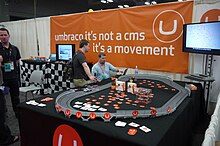Umbraco/FAQ
| This page may need to be updated to reflect current knowledge. You can help update it, discuss progress, or request assistance. |
This is a list of frequently asked questions.
Hosting[edit | edit source]
Where can I host Umbraco?[edit | edit source]
Umbraco offers an official cloud hosting service
Many webhosts also offer Umbraco hosting.
If you have your own datacenter or server, it's possible to host Umbraco yourself.
Installation[edit | edit source]
While the installation process, a 'invalid object name umbracoUser' error occures[edit | edit source]
This error may appear, if the web.config-key "umbracoEnableStat" is changed from false to true prior the installation. The key must not be changed to anything else than false until the installation procedure using the wizard is completed.
It seems it is possible that the installation is ready to continue but for some reason does not do so. Try browsing to http://localhost/install and setup might continue (if your installation is in http://localhost)
This error may also appear when umbraco is installed in a virtual directory. When your virtual directory is named myvirtualdir, change the web.config in a way that the keys umbracoReservedPaths and umbracoPath contain the name of the virtual directory, like
<add key="umbracoReservedPaths" value="/myvirtualdir/umbraco,/myvirtualdir/install/" /> and <add key="umbracoPath" value="/myvirtualdir/umbraco" />
The above is perhaps misleading, Umbraco does not support being installed in a virtual directory.
After successful installation a 'No node found' error occures[edit | edit source]
After successful installation the following error occures:
No node found (http://localhost/default.aspx?umbPage=/default.aspx, '/root/node [@urlName = ""] | /root/node')
This is because there aren't any pages yet. Go to your administration area (http://foo.bar/umbraco), login and create some content first.
Getting Started[edit | edit source]
I've installed Umbraco, now what?[edit | edit source]
There are three screencasts here which will introduce you to the Umbraco UI and how to get started creating Document types and templates.
Configuration[edit | edit source]
Email Configuration[edit | edit source]
Where can I configure my SMTP server?[edit | edit source]
The SMTP server is set in the web.config file which is in the root folder of your Umbraco installation.
You need to set the following key:
<add key="umbracoSmtpServer" value="127.0.0.1"/>
How can I change the email address that notifications are sent from?[edit | edit source]
The sender of notifications is set in the umbracoSettings.xml which is in the config folder under the root of your Umbraco installation.
You need to modify the following section to contain the e-mail address you wish to use as the sender:
<notifications> <!-- the email that should be used as from mail when umbraco sends a notification --> <email>darren@xxxx.com</email> </notifications>
You might also need to change the settings in formHandlers.xml located in the same directory
<parameter alias="sender">robot@umbraco.dk</parameter>
How can I change the text in the Umbraco notifications Email?[edit | edit source]
The notification Email message is set in the appropriate localised xml file for he language that you are using in the directory umbraco\config\lang under your Umbraco installation directory.
You will need to modify the following section:
<area alias="notifications" version="2.1"> <key alias="notifications" version="2.1">Notifications</key> <key alias="editNotifications" version="2.1">Edit your notification for %0%</key> <key alias="mailSubject" version="2.1">[%0%] Notification about %1% performed on %2%</key> <key alias="mailBody" version="2.1"> Hello %0% This is an automated mail to inform you that the task '%1%' has been performed on the page '%2%' by the user '%3%' Go to http://%4%/umbraco/default.aspx?section=content&id=%5% to edit. </key> </area>
Umbraco settings[edit | edit source]
How could I set a default 404 error page?[edit | edit source]
Open /config/umbracoSettings.xml Find the line that says <error404>1</error404> and replace 1 with the id of the page you want to show.
<errors> <!-- the id of the page that should be shown if the page is not found --> <error404>1</error404> </errors>
If you are using IIS7 you have to add the following to web.config;
<system.webServer> <httpErrors existingResponse="PassThrough" /> </system.webServer>
How could I Use DirectoryUrls?[edit | edit source]
Why should you enable this? This changes the links to the pages from example http://www.mydomain.com/news.aspx to http://www.mydomain.com/news
Open /config/umbracoSettings.xml Find the line that says <umbracoUseDirectoryUrls>false</umbracoUseDirectoryUrls> and replace false with true. It should then be like this
<umbracoUseDirectoryUrls>true</umbracoUseDirectoryUrls>
Then you have to let IIS handle all requests.
IIS 6.0 2003 server[edit | edit source]
Follow these instructions [1]
Templating[edit | edit source]
How could I display a page with an alternative template?[edit | edit source]
Just set the 'altTemplate' parameter in the query string to the alias of your desired template. For example
http://foo.bar/page.aspx?altTemplate=MyAltTemplateAlias
Rich-Text Editor[edit | edit source]
How do I change the stylesheet that is used in the built-in editor?[edit | edit source]
You can change the behavior by adding some editor css to the first stylesheet in the list.
#holderBody {
background: #fff;
}
#holder {
border: 1px solid #ccc;
padding: 10px;
margin: 5px;
text-align: left;
}
Where can I get help?[edit | edit source]

Help is available from
- Umbraco Forum: https://our.umbraco.com/forum